Help for Common Problems
Table of Contents
- Overview
- Setup For Java Web Start Launchers
- Personal Shortcuts
- Security Rules
- Setup For Standalone Java Applications
-
Common Problems
- Nothing happens when you click an application button
- Clicking an application button just shows a web page with XML/HTML code or other text
- Java Web Start attempts to load application but fails: Unable to launch the application
- Application loads with less memory than specified
- Down for Maintenance
- Error sending login request to server: null
- Java Web Start loads and gives Application Blocked by Java Security error
- On high resolution monitor, client application is too small
- Something else?
- Java Installer Download links
Overview
Our Java client applications, in the Java Web Start and Standalone Applications sections, require Java 11 or later.
Additionally, the Java Web Start applications require OpenWebStart to launch.
Java Web Start is no longer supported/included in Java 11 or later, https://www.openwebstart.com
now provides this functionality.
Users that want to use the Landslide Java Web Start clients can download and install OpenWebStart.
OpenWebStart has similar operations as the legacy Java Web Start and may even be an improvement,
especially as the open source community adds features.
The OpenWebStart Settings application (on Windows:
Anywhere below that we mention associating .cgi or .jnlp files with javaws should be associated with OpenWebStart's javaws executable (on Windows:
We provide Java 11 JRE installers below Java Plug-in Download links.
If you want to use Java 17 or later, the Landslide Client requires extra configuration. See the Using Java 17+ section in Client Specific Information for more details.
If you want to learn more about configuring your OpenWebStart, read its documentation https://www.openwebstart.com.
Setup For Java Web Start Launchers
When clicking on one of the Java Web Start application launchers,
the browser should return a .jnlp file and always ask to save it locally.
You can just choose to download the file and then execute it locally using your OpenWebStart javaws application.
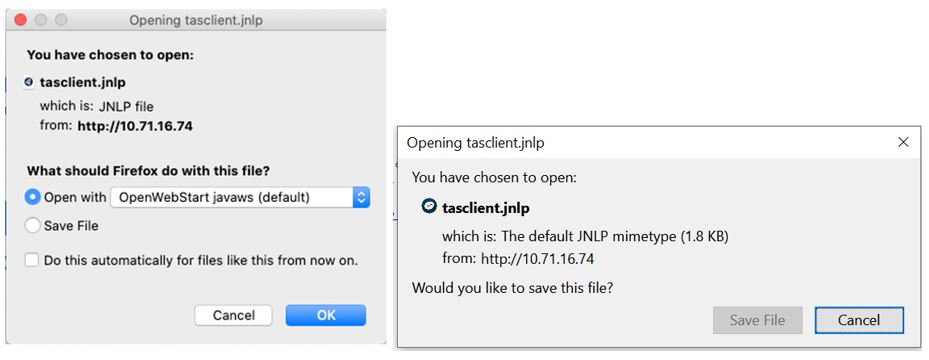
In the latest versions of browsers you most likely will only have the option to save the file (second image).
Treat the saved file as a temporary file until reading the next section.
The OpenWebStart installer should have associated jnlp files with its javaws already, if not, you can do it yourself.
The OpenWebStart executable, javaws, can be found in the root of the OpenWebStart installation directory, e.g.:
C:\Program Files\OpenWebStart\javaws.exe
Personal Shortcuts
If you want a desktop shortcut for your Landslide Java Web Start applications, use OpenWebStart's ability to add a shortcut for you. See the Saving Shortcuts section in Client Specific Information for more details.
If instead you manually save the .jnlp file to your desktop or other location for re-use, you must remember to replace this file anytime the TAS is upgraded.
If/when we make changes to the jnlp file, your client may fail to load or have strange unexplained issues caused by your old jnlp file.
Once downloaded you can rename the shortcut:

If this launcher file ever stops working properly you may need to just refresh it by launching the application from the Homepage again and replacing the file.
Security Rules
On some systems you may need to make exception to the security rules for our applications. They are signed with an official code signing certificate, but your system needs to trust the certificate. For example on MAC:
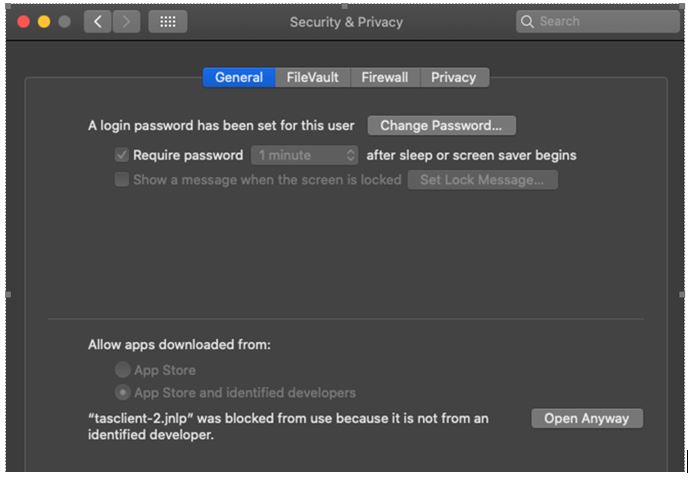
Setup For Standalone Apps
When clicking on one of the standalone application launchers, the browser should return a .jar file and always ask to save it locally. The file should just be saved to your desktop or other location and then executed with Java. You could also make a shortcut and/or a startup script (.bat/.sh) that calls the file, java -jar [NAME OF FILE]. Using a shortcut or startup script allows you to set the Java memory. See Standalone Client for more details.
Common Problems
-
Nothing happens when you click an application button
Make sure you have disabled your popup blocker.
Make sure you have enabled Javascript for the page.
Reload the homepage using HTTPS to approve the Certificate
Check browser's debug console (Click F12) for messages that offer insight
Lastly, try to login to the TAS Manager Web UI and if that doesn't work it means the TAS Web Application Service may be down. An admin can reboot and/or upgrade the TAS to try and correct the issue
If after all of these steps and still not working, contact support
-
Clicking an application button just shows a web page with XML/HTML code or other text.
This should only happen on Linux based clients. The browser is not properly associated with Java Web Start files. Unfortunately, you have to register Web Start manually as a helper app to Mozilla on non-Windows platforms. Here are the steps for Firefox:
Select Options > Applications and add the following settings.Content Type Action JNLP File User Java(TM) Web Start Launcher (Default)
The javaws executable should be in your OpenWebStart install directory, on Windows: OpenWebStartDir/javaws.exe, e.g. C:\Program Files\OpenWebStart\javaws.exe. -
Java Web Start attempts to load application but fails: Unable to launch the application.
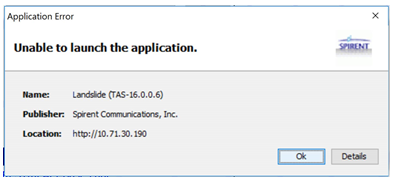
If you see an error like this,
- Confirm the latest/supported JRE 1.11+ is installed on your client system
- Confirm the correct JRE is associated with jnlip files
- Delete the OpenWebStart Temporary Internet Files (Clear Cache) via the OpenWebStart Settings application
-
If JRE 1.11 or greater is not installed
Use the Java Plug-in Download links below.
-
If supported Java is installed
the next step would be to clear the OpenWebStart Cache (Temporary Internet Files) from the OpenWebStart Settings, or clear it manually. The cache can be cleared manually by deleting everything under the directory indicated in the OpenWebStart Cache panel.
-
If you were attempting to run with more than 1.2G on a 32-bit Browser or JRE
See the User Guide section on the Java Plugin See the OpenWebStart section in Client Specific Information. or search the Spirent Knowledge Base for more help.
For more ideas see Client Specific Information -
Application loads with less memory than specified
Make sure Javascript is enabled for the page
Make sure you are using the JRE 1.11+.
See Java Plug-in Download links
See the Spirent Knowledge Base Article FAQ17827 for more information, or search for other articles. -
Down for Maintenance
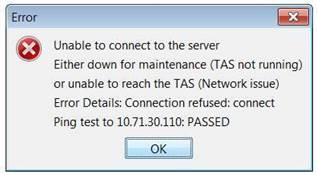
The Client is unable to establish a connection to the TAS. The reason is usually because the adminstrator put it down for maintenance. But it could also be because the Client is unable to reach the TAS. The Ping test is provided to indicate if the TAS is at least reachable, but this relies on your TAS allowing ping. See the OLH for more details about this error: TAS Down for Maintenance Indication
-
Error sending login request to the server: null
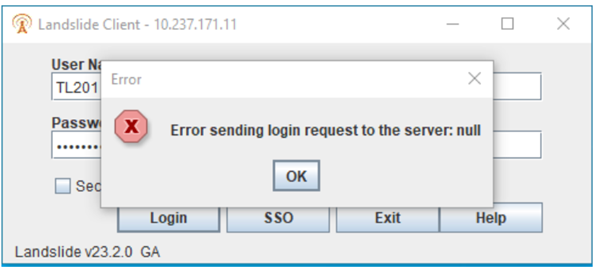
The Client is able to establish a connection to the TAS, but then fails to exchange the login messages. The usual culprit is a bad network configuration or firewall that is prevening bi-directional communications. Use troubleshooting tools like Wireshark to trace the connection and work with IT department to understand what is happenning. The Shift-Alt-L Logger in the client may contain more details as well as the full OpenWebStart or Java Console.
-
OpenWebStart loads and gives Application Blocked by Java Security error
Go to the OpenWebStart, Server Whitelist Tab and add an Exception for your TAS's IP address. For more information: See the Spirent Knowledge Base Article SOL13003 See the Using Java 17+ section in Client Specific Information.
-
On high resolution monitor, client application is too small
If you are running on a newer very high resolution and large screen and your client applications appear very small, you may have to try to disabling a JRE option. Put " -Dsun.java2d.dpiaware=false", in the "runtime parameters" of the Java version that Java Web Start is using, via your Java Control Panel. See SOL13440 for more information.
-
Something else?
Do you connect to the TAS via proxy? How to Configure Java Proxy Support
Did you try clearing your Java Cache and restarting? How to clear your Java Cache
Did you check your Java Console for additional error messages. How to enable your Java Console
Did you enable OpenWebStart consoles for additional error messages. Read documentation about the Logging tab
Java Plug-in Download links
Reminder: The Java Web Start Plug-in is no longer bundled as part of the Java Runtime Environment (JRE), OpenWebStart is installed separately.
The Landslide serves up local copies of the Windows, Linux, and Mac OS X versions. Versions
for other operating systems and architectures can be found at
Java Homepage/Manual Java Downloads,
or at one of the open source builder website.
AdoptOpenJDK or other open source builder.
Look for Java SE Runtime Environment (JRE) 11 downloads.
If there is something wrong with TAS, perform another upgrade using the latest Landslide.upg or Landslide.jar which will install Java 11 as needed.
If there are any problems go to the Java Homepage /Manual Java Downloads or AdoptOpenJDK website to find and install the proper version of the JRE.